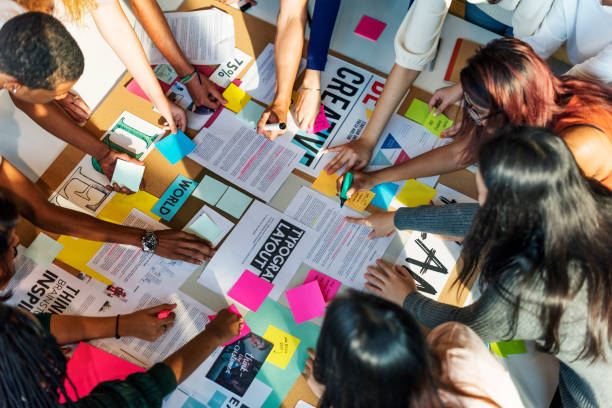Active learning techniques are a popular approach to teaching and learning that engage students in the learning process through active participation, collaboration, and problem-solving. This article highlights the different types of active learning techniques by contrast to traditional teaching methods.
Active learning techniques are popular in various educational settings, from K-12 classrooms to higher education and professional training programs.
This article will explore some of the different active learning techniques educators can use to promote deeper learning and improve student engagement and motivation.

Table of contents
- What is active learning?
- What are the benefits of using active learning techniques in the classroom?
- Top 10 types of active learning techniques?
- How can One Promote Active learning?
- What are some tips for incorporating active learning techniques into lesson plans?
- How can active learning techniques be used in higher education?
- What are some challenges to implementing active learning techniques in the classroom?
- Frequently Asked Questions
- In Conclusion,
- References
- Recommendations
What is active learning?
Active learning is a teaching approach that involves engaging students in learning through activities that promote critical thinking, problem-solving, and collaboration. Active learning techniques require students to https://media.istockphoto.com/id/665394574/photo/plan-creative-class-library-student-teacher-ideas-concept.jpg?s=612×612&w=0&k=20&c=P93l-CjulEfzW2xBEor_s7A6POFlWSU-VGYLAl7jjtY=be actively engaged rather than passively listening to a lecture or reading material.
Examples of active learning techniques include group discussions, case studies, problem-based learning, simulations, and role-playing activities. Active learning improves student engagement, motivation, and learning outcomes.
What are the benefits of using active learning techniques in the classroom?
Using active learning techniques in the classroom has several benefits for students and teachers.
Active learning techniques promote deeper learning and retention of knowledge. By engaging students in activities that require them to process information actively, they are more likely to remember what they have learned and to be able to apply that knowledge in new contexts.
Active learning techniques improve student engagement and motivation. When students are actively involved in their learning, they are more likely to be interested and invested in the subject matter. This can lead to increased participation, better attendance, and a more positive attitude toward learning.
In addition, active learning techniques help to develop critical thinking, problem-solving, and collaboration skills. These skills are essential for success in the 21st-century workplace and are highly valued by employers.
Using active learning techniques can lead to improved learning outcomes, increased student engagement and motivation, and the development of essential skills for success in the future.
You should see this article: What is the Hardest Year of High School? How to Scale Through.
Top 10 types of active learning techniques?
Virtual Collaborative Classrooms
Collaborative virtual classrooms improve the engagement of online learning. In addition to audio-video conferencing and chat, virtual classrooms offer synchronous and asynchronous annotation, communication, and resource sharing for facilitators and participants. It is a must-have for any eLearning platform!
Read this article: What is a Quaker School? (Full Explanation with FAQs)
Brainstorming / Mind Mapping
These two approaches are also active learning methods. Mind mapping and brainstorming are standard problem-solving methodologies. During these sessions, students generate ideas and post them on a whiteboard. It is one of the different types of active learning techniques.
The students then choose the best ones as a group and use them to devise a solution. There are apps available for these methods that allow learners to use their devices and collaborate with others to create a mind map or idea tree.
Have you seen this article: What Is ESOL In Education? (Full Explanation With Faqs)
Treasure Hunts
Another enjoyable and engaging activity involving the use of the company knowledge base. Scavenger hunts begin with a customer complaint. The learner’s task is to navigate the system and locate the most appropriate resource to address the problem. It familiarizes learners with the design and prepares them for real-world customer scenarios. It is one of the different types of active learning techniques.
Role Playing
Another practical approach based on active learning methods is role-playing. Role play simulates real-life situations that necessitate problem-solving abilities. More importantly, it serves as a means of measuring actual performance.
Job simulations such as customer interaction (facilitator plays the customer, learner the agent) over the phone, email, chat, or, in some cases, virtual reality are examples of role-playing activities. It is one of the different types of active learning techniques.
Check out this article: What is Intervention in Education (Full Explanation with FAQs)
Data and Problem-Solving Tools
This exercise, which combines a scavenger hunt and a role-playing activity, is one of the more effective active learning strategies for adults. A case study (preferably from a typical customer scenario) is usually through a learner by the facilitator. In turn, the learner makes sense of the data and uses available resources to solve the case.
Read this article: What Is Seminary School? Why I will prefer Seminary School.
Online message boards
The online discussion boards are another proven strategy for active participation. Online boards are virtual bulletin boards where students can collaborate to learn. They post questions and respond to them.
Most of the time, there is little intervention from a facilitator or subject matter expert, with most answers coming from other participants who are more knowledgeable. It is one of the different types of active learning techniques.
You should see this article: What is the Hardest Year of High School? How to Scale Through.
Learning by teaching
Learning by teaching entails allowing students to prepare and teach their peers’ lessons (or portions of tasks). Although the facilitator is taking a hands-off approach in this method, it involves a very elaborate process in which the facilitator serves as both moderator and subject matter expert.
Note that learning by teaching does not simply imply a presentation or lecture the students give. In this approach, the learners are the ones who facilitate the session by interacting with their peers. The facilitator ensures the learning is processed correctly and assists the student hosts. The most common media for this methodology are webinars and online discussion boards.
Have you seen this article: What is a Quaker School? (Full Explanation with FAQs)
The Jigsaw Method
Another approach that fully reaps the benefits of active participation and collaborative learning is the Jigsaw Technique. Learners get a “piece of the puzzle” to solve independently in this approach. Following that, they must work with other students to complete the puzzle.
This approach would be an excellent complement to role-playing and using data/tools to solve more significant problems and provide participants with a glimpse of the ‘bigger picture.’ It is an excellent exercise to help students understand their role in the larger picture by doing individual and collaborative work and how they are all part of the same process.
The ‘Flipped Classroom’
The term “flipped classroom” is relatively new in the learning and tech industries. They flip lessons, meaning most of the work, such as reading and research, is outside class. This is in contrast to the traditional approach, in which lectures take up most class time and assign activities as homework.
When they flip a classroom, the facilitator has more time to implement active learning methods during class. This concept focuses on making better use of class time by having fewer (or no) lectures and more activity time. It is one of the different types of active learning techniques.
Check out this article: LNAT Universities 2023| Universities that Require an LNAT
Game-Based Learning
GBL is arguably the most enjoyable of all active learning methods. Game-based learning, or gamification, turns a specific aspect of education (or business) into a game. Learning apps allow you to do this, but you can also create your own! It is one of the different types of active learning techniques. Remember to incorporate the three gamification elements – achievement, competition, and fun – into the endeavor.
There are still a plethora of activities for active learning methods available. Thanks to technological advancements, learning managers and professionals now have more options for engaging today’s tech-dependent audience. Nonetheless, it is only a matter of time before technology advances and learning methodologies evolve.
Read this article: What is Enrichment in School? (Full Explanation with FAQs)
How can One Promote Active learning?
There are several ways to promote active learning in the classroom:
- Use various active learning techniques: Incorporate multiple active learning techniques such as group discussions, case studies, problem-based learning, simulations, and role-playing activities to keep students engaged and motivated.
- Encourage student participation: Encourage students to participate actively in the learning process by asking open-ended questions, soliciting opinions and feedback, and creating opportunities to share their ideas and perspectives.
- Provide regular feedback: Give students regular feedback on their performance to help them stay on track and adjust their learning strategies as needed.
- Set clear learning objectives: At the start of each lesson or activity, set clear learning objectives to help students understand what they are to learn.
- Create an interactive learning environment: Use technology, multimedia resources, and interactive tools to create an engaging and dynamic environment that promotes active learning.
- Foster a collaborative learning culture: Encourage student collaboration by creating opportunities for group work, peer review, and feedback. This can help students develop teamwork and communication skills while deepening their understanding of the subject.
- Make learning relevant and contextual: Connect the subject matter to real-world issues, problems, or situations to help students see the relevance of what they are learning and motivate them to apply their knowledge practically.
Have you seen this article: What Is Executive Golf Course? 2023 Enrollment
What are some tips for incorporating active learning techniques into lesson plans?
Here are some tips for incorporating active learning techniques into lesson plans:
- Start with clear learning objectives: Identify what your students want to learn and understand, then choose active learning techniques to help them achieve them.
- Use various techniques: Incorporate multiple active learning techniques to keep students engaged and motivated. For example, you could use group discussions, case studies, problem-based learning, simulations, and role-playing activities.
- Incorporate technology: Use technology and multimedia resources to create an interactive and engaging learning environment. For example, you could use online discussion forums, video clips, and interactive simulations to support active learning.
- Provide clear instructions: Provide clear instructions and expectations for each active learning activity to ensure that students understand what they are supposed to do.
- Encourage participation: Encourage participation by creating a safe and inclusive learning environment. Provide opportunities for students to share their ideas and perspectives and avoid criticizing or dismissing their contributions.
- Assess learning outcomes: Use assessment techniques that align with your active learning objectives to evaluate student learning outcomes. For example, you could use group presentations, case study analyses, or reflective essays to assess student learning.
- Reflect and improve: Reflect on the effectiveness of your active learning techniques and make adjustments as needed. Ask students for feedback on what worked well and what could be improved, and use this feedback to refine your lesson plans over time.
You should see this article: In What Country Is It Easiest to Become a Doctor?
How can active learning techniques be used in higher education?
Active learning techniques can be used in higher education to create a more engaging and effective learning environment. Here are some ways to incorporate active learning techniques into higher education:
Flipped classroom model
In the flipped classroom model, students review lecture material before class, making in-class activities more interactive and engaging.
Collaborative learning
Encourage collaborative learning by incorporating group discussions, projects, and team-based learning activities. This can help students develop communication and teamwork skills while deepening their understanding of the subject matter.
You should see this related article: What does an Electric Filter do? (Full explanation with FAQs)
Problem-based learning
Use problem-based learning activities to help students apply their knowledge to real-world problems and situations. This can help students develop critical thinking and problem-solving skills while making the learning experience more engaging and relevant.
Simulations and role-playing activities
Use simulations and role-playing activities to help students understand complex concepts and issues. This can help students develop empathy, communication, and decision-making skills while making the learning experience more interactive and fun.
Check out this article: What Are the Different Types of Executive-Level Jobs in 2023? How to Apply.
Active listening and note-taking
Encourage active listening and note-taking by asking students to summarize key points and take notes during lectures and discussions. This can help students stay engaged and retain information more effectively.
Peer review and feedback
Peer review and feedback activities help students develop communication and critical thinking skills while providing constructive feedback on their work.
Active learning techniques can help higher education institutions create a more engaging and effective learning environment that supports student learning and success.
Read this article: What Does a Chief Cook Do? Full Explanations with FAQs.
What are some challenges to implementing active learning techniques in the classroom?
Implementing active learning techniques in the classroom can be challenging. Some common challenges include:
- Resistance to change: Some instructors and students may resist change and prefer more traditional teaching methods.
- Time constraints: Incorporating active learning techniques may require more time and effort in planning, preparation, and classroom management.
- Lack of resources: Some active learning techniques may require specific equipment or materials that are not readily available.
- Large class sizes: Active learning techniques may be more challenging to implement in larger classes, where individual attention and participation can be difficult to manage.
- Student engagement: Students may only be equally engaged in active learning activities, and some may prefer more traditional teaching methods.
- Assessment and grading: Grading and assessing student performance may be more challenging with active learning techniques, as traditional assessment methods may not be applicable or require additional resources.
Addressing these challenges and finding ways to overcome them is essential to implement active learning techniques in the classroom successfully. This may require collaboration with colleagues, seeking professional development opportunities, and being open to experimentation and innovation in teaching practices.
Have you seen this article: What Is ESOL In Education? (Full Explanation With Faqs)
Frequently Asked Questions
Active learning is a teaching approach that involves engaging students in learning through activities that promote critical thinking, problem-solving, and collaboration.
Active learning techniques can improve student engagement, motivation, and learning outcomes. They also promote the development of critical thinking, problem-solving, and collaboration skills.
Examples of active learning techniques include group discussions, case studies, problem-based learning, simulations, and role-playing activities.
Active learning techniques can be used in higher education by incorporating them into lesson plans, encouraging student participation, and creating interactive learning environments.
Some tips for incorporating active learning techniques into lesson plans include setting clear learning objectives, using various methods, encouraging student participation, and providing feedback on student performance.
In Conclusion,
Active learning techniques offer a valuable alternative to traditional teaching methods by engaging students in the learning process and promoting deeper learning. By using various active learning techniques, educators can help students develop critical thinking, problem-solving, and collaboration skills essential for success in the 21st century.
Active learning techniques improve student engagement, motivation, and learning outcomes in K-12 classrooms, higher education institutions, or professional training programs.
Educators can create dynamic, interactive learning environments that foster creativity, innovation, and lifelong learning by incorporating active learning techniques into their teaching practice.
Check out this article: What is Intervention in Education (Full Explanation with FAQs)
References
- https://libguides.usd.edu.
- https://www.practicaladultinsights.com
- https://www.cybintsolutions.com
- https://www.celt.iastate.edu




